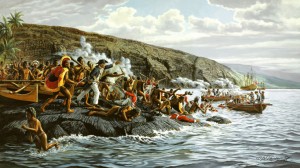by Elizabeth C. Goldsmith (W&M Contributor)
Most sailors, up until the late nineteenth century could not swim. Why not? I’ve read that it was because European and English sailors were afraid of the cold Atlantic and that many sailors came from landlocked regions where it was thought that immersion in water would only bring disease or death. Water was dirty, and usually cold. And if you were unfortunate enough to fall overboard on a sea voyage, you could not expect to be saved, so it was better to die quickly.
A few early seafarers were famously good swimmers. In a narrative of his father’s life, the son of Christopher Columbus reported that his father had jumped from a burning ship during a sea battle, swimming several miles to shore, while most of his companions, unable to swim, either died on the boat or in the water. The fictional adventurer Robinson Crusoe saved himself from a shipwreck because he could swim. And when he first saw the clever man who would become his servant, Friday was escaping from his captors by swimming away from them. This popular tale did not, however, inspire many real life sailors of the eighteenth century to learn how to keep themselves afloat.
Captain James Cook, whose extraordinary voyages took him thousands of miles around the globe in uncharted waters, died in a violent confrontation on the shoreline of Hawaii. He may well have been able to save himself by jumping in the water, where a group of his men were trying to manoever a boat to reach him just off shore. Who knows, if he had been able to swim he might have returned to England and died at home of some landlubber’s disease, like Christopher Columbus.
The death of Cook, February 14, 1779. Painting by Herb Kawainui Kane
The earliest sailors in the South Pacific were another story. The amazing pioneers who over 900 years ago somehow crossed 2500 miles to Hawaii in outrigger canoes must have been able to swim. And swimming in the warm and clean waters of sparsely populated Polynesia seems to have been something that everyone did – to the astonishment of the first European crews who, arriving off the shores of Tahiti, saw men and women bobbing toward them in the water. No wonder they thought they were seeing mermaids.


